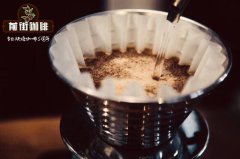Colombian Kaddura coffee bean Kaddura coffee bean flavor is obviously sour and bright as a whole

Professional coffee knowledge exchange more coffee bean information please follow the coffee workshop (Wechat official account cafe_style)
Front Street-introduction to Kaddura, Colombia
The Colombian Coffee producers Association (Federacion Nacional de Cafeteos de Clolmbia), known as [FNC] for short in the industry, introduced the two main varieties of Colombian coffee, Kaddura and Colombia.
Kaddura, which was introduced from Brazil in the 1960s, now accounts for 45-50% of the country's output and has replaced the earliest Tibica.
The new breed [Colombia], which has the same name as Colombia, is a mixed-race coffee developed in the 1980s, with Kaddura and Timo ancestry, that is, the notorious Katim, but [FNC] insists that although Colombia is a direct line of Katim, its flavor is far more elegant than that of ordinary Kadim, because Colombia has washed away the moldy smell of strong beans after generations of "reverse hybridization" with Arabica, and the flavor is more like Arabica. It also has the advantages of disease resistance and high yield of stout beans, which is a sharp weapon for Costa Rica to increase production.
Kaddura (Caturra), a natural variety of Arabica variety bourbon, was discovered in Brazil in 1937. Its tree is not as tall and shorter as bourbon. Due to inheriting the blood of bourbon, the resistance is relatively weak, but the yield is higher than that of bourbon. Although found in Brazil, Kaddura is not suitable for growing in Brazil, so it is not planted on a large scale in Brazil, but is popular in Central and South America, such as Colombia, Costa Rica and Nicaragua. Kaddura is planted on a large scale.
Kaddura is easy to harvest because of its short trees, but it is a pity that, like bourbon, it has a periodic problem of production capacity fluctuation every two years. Flavor and bourbon beans are comparable or slightly worse, more important is super adaptability, do not need shade trees, direct exposure to the sun can also be full of vitality, commonly known as exposed coffee (Sun Coffee). At the same time, Kaddura can adapt to high-density planting, but more fertilizer must be applied to increase the cost. In academic circles, some people call Kaddura the bourbon of dense and exposed version, which can be said to hit the nail on the head.
At the site where Kaddura is planted, the higher the altitude, the higher the quality, but the corresponding yield is also less. Compared with these botanical characteristics, people may be more concerned about the taste of Kaddura.
Knowledge: Ethiopia is in the position of meta-ancestor in the coffee industry, is the birthplace of Arabica beans (Arabica), and is currently the largest Arabica producer in Africa. The Kaffa forest in Ethiopia is more known as the "coffee gene bank".
In short: Qianjie is a coffee research hall, happy to share the knowledge about coffee with you, we share unreservedly just to make more friends fall in love with coffee, and there will be three low-discount coffee activities every month. The reason is that Qianjie wants to make more friends drink the best coffee at the lowest price, which has been Qianjie's tenet for 6 years!
END
Important Notice :
前街咖啡 FrontStreet Coffee has moved to new addredd:
FrontStreet Coffee Address: 315,Donghua East Road,GuangZhou
Tel:020 38364473
- Prev

American boutique Colombian anaerobic sun moonlight full-bodied fruit intoxicating wine
Professional coffee knowledge exchange more coffee bean information please follow the coffee workshop (Wechat official account cafe_style) front street-Colombia anaerobic sun moonlight introduction Colombia, the world's third largest coffee producer, is considered to be the best coffee producing area in South America, the coffee flavor is bright, fruity, vibrant, Colombia has some of the most ideal coffee in the world
- Next

Introduction to the three major manors in Colombia the Columbia Tree Manor
Professional coffee knowledge exchange more coffee bean information please follow Coffee Workshop (Wechat official account cafe_style) Front Street-Columbia Tree Manor introduces Colombia's suitable climate provides a real sense of natural pasture for coffee. Coffee trees in Colombia are mainly cultivated in the Andes, on steep slopes about 1300 meters above sea level, where the year-round temperature is about
Related
- Beginners will see the "Coffee pull flower" guide!
- What is the difference between ice blog purified milk and ordinary milk coffee?
- Why is the Philippines the largest producer of crops in Liberia?
- For coffee extraction, should the fine powder be retained?
- How does extracted espresso fill pressed powder? How much strength does it take to press the powder?
- How to make jasmine cold extract coffee? Is the jasmine + latte good?
- Will this little toy really make the coffee taste better? How does Lily Drip affect coffee extraction?
- Will the action of slapping the filter cup also affect coffee extraction?
- What's the difference between powder-to-water ratio and powder-to-liquid ratio?
- What is the Ethiopian local species? What does it have to do with Heirloom native species?

